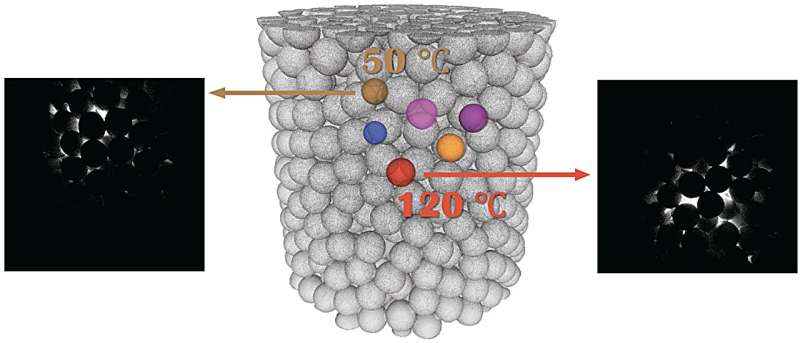This article has been reviewed according to Science X's editorial process and policies. Editors have highlighted the following attributes while ensuring the content's credibility:
fact-checked
proofread
Multi-point temperature measurements in packed beds using phosphor thermometry and ray tracing simulations

A team of researchers has proposed an indirect optical method for determining internal temperatures of opaque packed beds based on phosphor thermometry. This method enables simultaneous multi-point measurements using an image-based separation of the superimposed luminescence originating from sources at different locations.
Combined with the ray tracing simulation, it has the potential to perform the measurements in irregularly packed beds of particles with arbitrary shapes. The results can be utilized as input to a finite element heat transfer simulation, allowing for optimizing the simulation parameters and thus obtaining an accurate full temperature distribution within the bed.
The team of researchers from Otto-von-Guericke-Universität Magdeburg published their work in the journal Particuology.
Packed beds are the most common industrial reactor, typically composed of particles of random shapes, and the reactions in them occur very often at high temperature. The measurement and control of the packing particle temperature in the beds are thus crucial to optimize product quality, the energy efficiency of the systems, and pollutant emissions.
Given the inherent randomness in the size and distribution of pores within a packed bed, coupled with the opacity of the packing material, the accurate measurement of the global temperature distribution inside the bed poses significant difficulty. Therefore, researchers and engineers frequently resort to numerical simulations to analyze the internal temperature characteristics of packed beds, which offers a means to overcome the limitations of direct measurements.
However, the numerical simulation of thermochemical processes in packed beds is also very challenging due to the large domain size, the multi-scale nature of the problem, and the different heat transfer modes that are presented, including convection, particle-to-particle conduction, and radiation.
Even in the absence of radiation, convection, and chemical reactions, the simulation of heat transfer in packed beds remains particularly intricate due to the difficulty in resolving complex particle surface properties at contact points and the variability inherent in the packing structure due to the particle filling step.
Notably, surface roughness can significantly influence particle-to-particle heat transfer when dealing with particles of high thermal conductivity and regular geometries like cubes. Although the implications of such roughness can theoretically be modeled by a minor air gap between particles, effective simulation necessitates prior knowledge of this gap size, which is often unattainable because of its various determinants, such as particle manufacturing methods.
It is, therefore, crucial to have accurate local temperature measurements within the packed bed, especially for multi-point measurements, which can provide information on the direction and magnitude of heat transfer rates.
In their recent paper, the team of scientists developed an indirect thermometry method to measure the internal temperature of packed beds experimentally. This method relied on a combination of lifetime-based phosphor thermometry, ray tracing simulations, and temperature data assimilation using finite element heat transfer simulations.
Researchers designed a reproducible regular packing of 6 mm diameter aluminum spheres to establish and validate the method, with one sphere in the top layer being electrically heated. When spheres inside the packing were coated with thermographic phosphors and excitation light was directed toward the packing, phosphor coatings would be excited indirectly as the laser propagated through the bed by scattering between packing granules surfaces.
Consequently, the phosphor luminescence exiting the bed can be exploited to reconstruct the originating location and estimate the temperature at the reconstructed location.
Considering multiple luminescent particles presented in packed beds, the resulting luminescence field is a sum of the individual particle contributions. The research team proposed isolating each particle's relative contributions by linear regression of their radiative transfer.
For this, the key point was to obtain the individual particle intensity distribution functions, which provide the spatial distribution of the luminescence formed on the camera image while only one of the internal particles was emitting light. In simple setups where the packing was regular and repeatable, these distribution functions could be easily measured.
For complex cases of irregularly packed beds, an efficient alternative to obtain the functions was using ray tracing simulations where one could turn individual particles "on" and "off" at will. Multi-point temperature detections were used as input to finite element heat transfer simulations to determine parameters such as particle-to-particle air gap distance. With these, the full temperature distribution inside the bed could be assimilated from the measured values.
"This study provides a new option to determine multi-point temperature in opaque packed beds, allowing experimental validation of highly-resolved numerical simulations and offering insights into the complex interactions between chemical reactions and heat and mass." said author Guangtao Xuan, a Ph.D. student at Otto-von-Guericke-Universität Magdeburg.
"Next steps include increasing the particle amount of simultaneous measurements, further improving the accuracy of ray tracing simulation of the particle luminescence, and extending the demonstration to irregular packed beds." he said.
The team includes the scientists of Guangtao Xuan, Mirko Ebert, Simson Julian Rodrigues, Nicole Vorhauer-Huget, Christian Lessig, and Benoît Fond from the Otto-von-Guericke-Universität Magdeburg, Germany. The researcher Benoît Fond is currently working at ONERA—The French Aerospace Lab, France.
More information: Guangtao Xuan et al, Multi-point temperature measurements in packed beds using phosphor thermometry and ray tracing simulations, Particuology (2023). DOI: 10.1016/j.partic.2023.03.015
Provided by Particuology




















